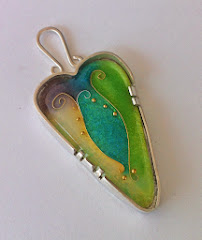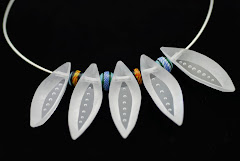The more I teach the more important it becomes to teach two major tools that are often overlooked. These tools aren't something you order from a catalog. If you already have a bead making set up on the planet earth, then you already have them: Gravity and the Flame. I had a student who told me after a recent class that she had never been taught to use the different temperatures of the flame. She had almost given up on beadmaking because everything she made melted too fast and therfore could not produce detail work like other glass beads she had seen.
This made me realize how important it is for students to learn to use the entire length of the flame. Sometimes when I'm teaching I remind myself of my piano teacher. "Keep those elbows up!" or "don't slouch" she would say over and over. At least I don't use a ruler to "tap" on my students when they don't listen! The flame on a minor torch has a vast range of temperatures you can utilize for various techniques. Close to the torch the flame is about 1600 degrees. Following up the visible flame (with didium glasses) the temperature drops a hundred degrees every inch or so until the invisible part of the flame is about 900 - 1000 degrees. This is where you flame anneal your work before placing into the kiln set at 960. So even more important that in piano playing, you have to keep your elbows up so that your arms are free to move your glass creation around in the flame at the right temperature. Let's say your attempt at laying on a stringer worked and the most perfect curved line now appears on your bead. If your elbows are comforably resting on the table or rests, you may not be able to move it out of the hot flame in time to save it. If you have your elbows up and ready for action, you can move that nice raised stringer line to a cooler part of the flame and pulse the heat towards the stringer to make sure it is securely melted into the matrix of the bead, yet not melt it in too much.
I recommend reading an article by Jim Smircich on using the heat to create your bead. That's where I learned about it.
Try making a long barrel shaped bead in white. Then place horizontal black stringers on the bead spaced fairly evenly. After warming the entire bead, try directing the flame towards one section of the bead while you rotate the bead in a steady fashion. for example: Heat just one end of the bead or straight down the middle. when the stringer starts to melt in, and the glass starts to slightly flow, hesitate just a nanosecond, then rotate about a 1/8 of a turn and hesitate, etc. You will begin to see the lines start to sag, making a wavy line in the middle. Continue this untill all the lines in the middle are wavy. During this process you may find that the glass starts to flow too much and so you have to rotate AND move the bead higher in the flame. Remember that glass retains the heat and so the heat is accumulated and retained in the glass so that the same temperature flame will continue to make the glass warmer and warmer and warmer. It's always OK to move the bead up through the flame to the annealing area if you want to "freeze frame" an area of the bead you are working on. You can always go back and reheat the bead and make changes or additions.
Friday, June 20, 2008
Subscribe to:
Posts (Atom)


